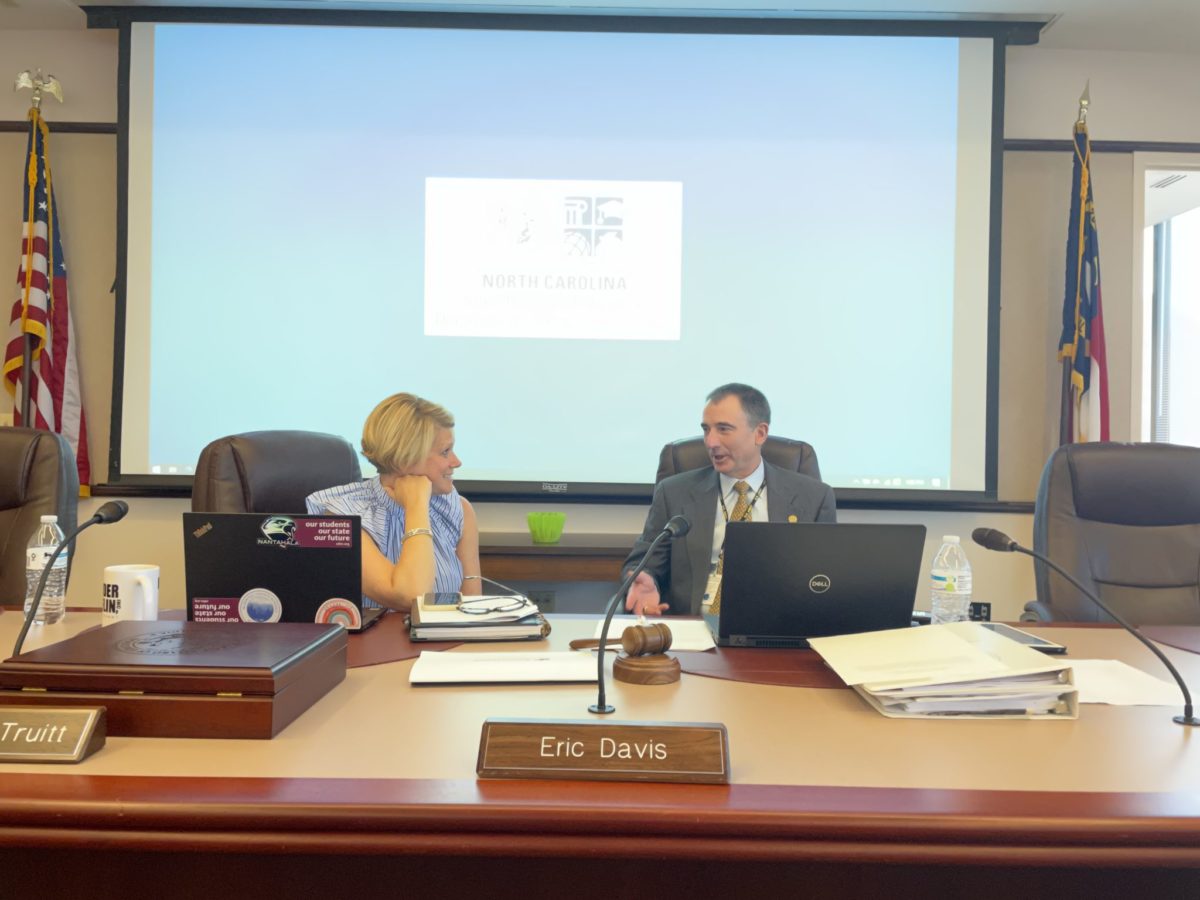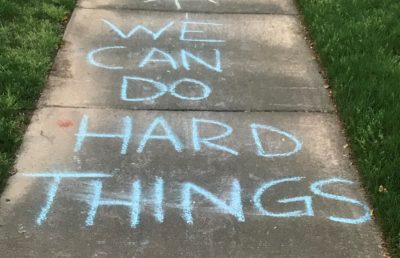

|
|
Should North Carolina schools require masks? How will the state track student growth in the wake of missed classroom time and testing? And can the state hold onto the billions of federal pandemic relief dollars pouring in?
These were some of the questions facing the State Board of Education during its August meeting, the last before schools open for a third year of pandemic-era learning. Presenters discussed short-term impacts of COVID-19 and members considered decisions that may well determine the pandemic’s long-term impact on students.
“We are entering a new phase in this battle, a potentially more threatening one than the phase we survived thus far,” State Board Chair Eric Davis said. “While we all value our own individual choices, in this battle our individual choices affect each other.”
Here’s what’s in this article. You can skip to any section by clicking the links below:
Wear a mask and get vaccinated, DHHS recommends — but does not require
Department of Health and Human Services (DHHS) Deputy Secretary Susan Gale Perry and Chronic Disease and Injury Section Chief Dr. Susan Kansagra said the percent of positive cases and number of hospitalizations due to COVID-19 has doubled over the past month, to 10.6% and 1,359, respectively.
The “sharp increase” occurs as the delta variant — which Kansagra said is “much more transmissible” — became the most prevalent strain of coronavirus in the state. With previous strains, she said, one individual could infect up to two more. With the delta strain, one individual could infect up to six.
In response, DHHS updated its StrongSchoolsNC Public Health Toolkit, most notably stressing the importance of vaccination and recommending that schools require all K-12 students and staff wear masks. The State Board voted to approve the updated toolkit. James Ford, who casted one of the two “no” votes, objected to the toolkit recommending masks, rather than requiring them.
“I can’t, in good conscience, approve of this toolkit which recommends, but does not require, mask wearing in schools,” he said. “The very thought of even one kid becoming sick is just too much for me to bear.”
Kansagra said there’s been a “whole host of studies” on the benefits of mask-wearing. She said the delta variant spreads through small respiratory droplets and that masks are effective in preventing those droplets from spreading.
”Our biggest focus right now is keeping kids in school,” she said. “Masks increase the ability for children to be in school.”
That’s partly because of quarantine guidelines set by state and local health directors. DHHS guidance says, in part, that students do not need to quarantine if they were in close contact with a positive case so long as both the positive case and those in close contact consistently and correctly wore face masks.
Union Academy Charter School in Monroe recently made headlines when it reversed its mask-optional policy after 14 students tested positive the first month back, resulting in more than 150 students and staff in quarantine. Statewide, school boards in at least 47 districts voted to make masks optional.
On Wednesday, Gov. Roy Cooper said he hopes school boards that have mask-optional policies will reconsider mandating masks.
Board member Kisha Clemons, former North Carolina Principal of the Year, said the safety of her students is top priority. She questioned mask-optional policies, as well as those eligible for the vaccine who choose not to get one.
“I want to make good on my promise to kids to make sure that they are safe and to make sure that I’m doing everything that I can,” she said. “And I do feel like there are decisions being made for me not to be able to do that.”
State Treasurer Dale Folwell, who said he was fighting for his life after getting COVID, prayed that people challenge their own assumptions and be open to new information.
“I’ve seen COVID in color,” he said, adding that as state treasurer he’s also seen “the impact it’s having on illiteracy and poverty in this state.”
DPI still awaiting more than $1 billion in relief funding
The state Department of Public Instruction (DPI) is trying to secure a portion of its allotment under the American Rescue Plan’s Elementary and Secondary School Emergency Relief (ESSER) Fund. The money, about $1.2 billion, is being held until the U.S. Department of Education approves DPI’s ESSER III plan.
DPI’s Office of Learning Recovery and Acceleration Executive Director Michael Maher said the Department of Education has only approved 17 states’ ESSER III plans so far, so North Carolina is not an outlier. But he cautioned that the state is not in an ideal position.
“It is really hard to think about how we provide wrap-around support and services and programs in a comprehensive manner that is built around best-available data and programs that we are already delivering without having a sense of what the larger pool of funding is going to be,” he said, referring to the pool of funding that the General Assembly controls.
The plan was initially submitted June 22, but the Department of Education flagged 10 items that required revision. The plan was resubmitted July 16 and on July 22 DPI was informed that all but two revisions were approved.
Addressing the final two revisions has proven challenging, though, because of the state budget process. Maher said North Carolina is one of only a few states that has its funding appropriated by a general assembly, and that has complicated the process.
One of the revisions the Department of Education requires is clarification on DPI’s consultation with certain stakeholders of at-risk students. However, Maher said they cannot have meaningful discussions with stakeholders without a comprehensive ESSER III appropriation plan from the General Assembly.
The second revision the Department of Education requires relates to assurances that funds will be used to “respond to the academic, social, emotional, and mental health needs of all students, and particularly those students disproportionately impacted by COVID-19.”
Maher said that DPI’s lack of control over the final appropriations could result in spending proposals that are not consistent with DPI’s pandemic recovery plan or the American Rescue Plan.
“If that happens, then the state will be required to repay those funds back with state dollars,” he said.
EVAAS will incorporate gap analysis to project student benchmarks and growth
The state’s accountability system measures growth and progress on three levels — for students, teachers, and schools. These measurements are captured by the Education Value-Added Assessment System (EVAAS), a software system that uses student testing history, with emphasis on the most recent academic year, to estimate student growth.
Teachers and researchers have questioned the use of EVAAS and the state’s school performance grading system, which is 80% dependent on performance and 20% on growth.
Still, the system in place relies on EVAAS data to create student benchmarks and compile aggregated data.
Due to the pandemic, students did not take end-of-year exams in 2019-20, many districts had difficulty administering beginning-of-year exams in 2020-21, and participation in end-of-year exams in 2020-21 was down slightly from pre-pandemic years.
Without this data, adjustments have to be made to EVAAS. There won’t be data available for school accountability growth — and this metric will not be used in school report cards, determination of low-performing schools, or calculation of principal recruitment supplements.
To create benchmarks for student growth expectation this school year, a gap year analysis will be conducted. The weight typically given to the most recent academic year in EVAAS will now include the two most recent academic years.
This means a student’s scores will represent that student’s performance under two different teachers. For that reason, DPI will turn off default access to teacher-level reporting, but districts will independently be able to choose to access this data.
State Board Vice Chair Alan Duncan voiced skepticism over the utility of this data, saying that gap-year analysis is not an acceptable way to critique teachers’ work this past year.
“We have teachers who have worked remarkably, remarkably hard through incredibly difficult circumstances over the course of the last two years,” he said. “They’re exhausted, they’re tired, and, in some sense, still under-appreciated.
“We as a Board need to be very strongly supportive of the work that they have done through this pandemic, and will continue to do, it appears, as we go into the new school year. To the extent any of this data is used as a way to criticize somebody — just put yourself in their shoes.”
A template for creating new standards
New standards are not a frequent occurrence, but they’re inevitable and — said State Superintendent Catherine Truitt — doing them well is important. Truitt has previously voiced her desire for a template for creating new standards.
Deputy Superintendent and Chief Academic Officer David Stegall informed her that an update to the North Carolina Standard Course of Study Procedures Manual — a template for creating new standards and transmitting the information and resources to districts — was created in 2018, but had never been presented to the State Board.
Now, Stegall and Deputy Superintendent Catherine Edmonds are leading efforts to improve the 2018 update.
Improvement efforts will focus on addressing resource inequities among the districts. It’s more challenging, Stegall and Edmonds said, for districts with fewer resources or a high number of new teachers to implement new standards. On Wednesday, Stegall and Edmonds previewed the efforts and will present the finished product at a later date.
“I think you’ve highlighted a serious resource issue,” Davis said. “It’s more than just providing effective tools — we need to do all that, we need to do it as efficiently as we can, and we need to improve what we deliver to our districts. But in a state with the abundant resources that North Carolina has, it’s shameful that districts don’t have the staff they need to do the work. And I think it’s inherent upon us to call for that staffing.”





